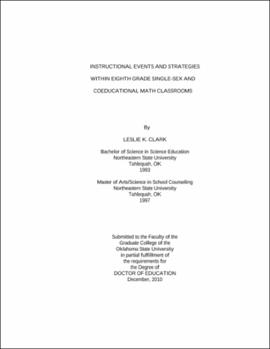| dc.contributor.advisor | Stern, Kenneth | |
| dc.contributor.author | Clark, Leslie K. | |
| dc.date.accessioned | 2013-11-26T08:34:19Z | |
| dc.date.available | 2013-11-26T08:34:19Z | |
| dc.date.issued | 2010-12 | |
| dc.identifier.uri | https://hdl.handle.net/11244/7349 | |
| dc.description.abstract | Scope and Method of Study: | |
| dc.description.abstract | The purpose of this case study was to gain a better understanding of the instructional events and strategies in classrooms where the instructors taught both single-sex and coeducational math within a public middle school. Gagn's (1985) theory of instruction provided the framework and informed the findings of this study (See also Gagn & Medsker, 1996) in which instructional strategies were observed within the context of nine instructional events that promote learning: gaining attention, informing students of the objective, stimulating recall prior to learning, presenting the content, providing learning guidance, eliciting performance, providing feedback, assessing performance, and enhancing retention and transfer. Data collection included classroom observations, audio-taped interviews, video-recorded observations and artifacts. | |
| dc.description.abstract | Findings and Conclusions: | |
| dc.description.abstract | The findings of this study indicated some differences and similarities between single-sex and coeducational classes taught by the same teacher in a variety of areas: frequency of instructional strategies used to incorporate instructional events, challenges, and general themes. Thematic areas were identified throughout the study that may further our understanding of single-sex and coeducational classes: enrollment, interactions, movement, bullying behaviors, academic expectations, willingness to volunteer, and disciplinary interruptions. Related thematic areas included professional development opportunities and evaluation of single-sex classes. | |
| dc.description.abstract | Instructors who teach single-sex and coeducational classes may assume there are no instructional differences when differences exist. Both instructors in this study declared there were no instructional differences between the single-sex and coeducational classes, yet differences were identified. Professional development that addresses the specific needs of students in single-sex classes may enlighten instructors to subtle differences. Students enrolled in single-sex classes are more likely to interact with the teacher and with their peers. Interactions within single-sex classes appeared to be open-ended and spontaneous compared to the purposeful and limited interactions in the coeducational classes. | |
| dc.format | application/pdf | |
| dc.language | en_US | |
| dc.rights | Copyright is held by the author who has granted the Oklahoma State University Library the non-exclusive right to share this material in its institutional repository. Contact Digital Library Services at lib-dls@okstate.edu or 405-744-9161 for the permission policy on the use, reproduction or distribution of this material. | |
| dc.title | Instructional events and strategies within eighth grade single-sex and coeducational math classrooms | |
| dc.contributor.committeeMember | Harris, Ed | |
| dc.contributor.committeeMember | Perry, Katye | |
| dc.contributor.committeeMember | Self, Mary Jo | |
| osu.filename | Clark_okstate_0664D_11105.pdf | |
| osu.accesstype | Open Access | |
| dc.type.genre | Dissertation | |
| dc.type.material | Text | |
| dc.subject.keywords | educational administration | |
| dc.subject.keywords | educational leadership | |
| thesis.degree.discipline | Teaching and Curriculum Leadership | |
| thesis.degree.grantor | Oklahoma State University | |
